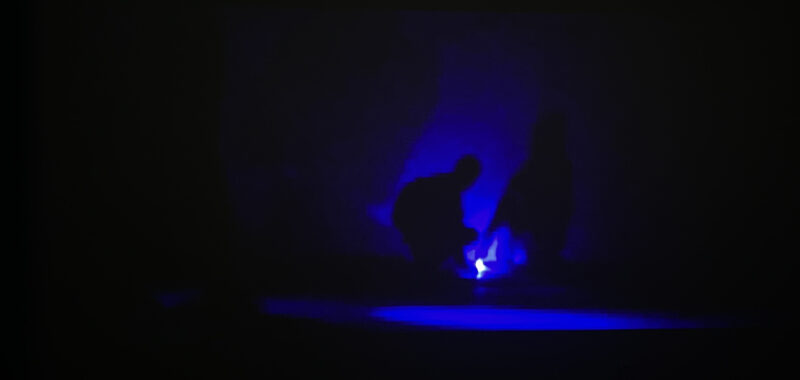LOS ANGELES — I locked my phone in the required case, grabbed a tiny LED flashlight, and parted the thick black curtains. It was extremely still, an eerie kind of dark. A docent announced himself and welcomed me into the space — a disembodied voice that both startled and calmed me. I walked slowly, the darkness stunting my gait. I turned on my flashlight, and an orb of dark blue appeared before me on the ground.
It’s strange to willingly enter a controlled space that you are utterly unable to navigate. I can’t say that I was afraid, but it felt like I was preparing for fear. I wondered if the exhibition’s title — Concerto in Black and Blue — was an allusion to the pain of persecution, suggesting bruises and uniforms, race and sentiment. It felt like there were only two choices: Lean into the lawlessness or escape from it.
This exhibition by David Hammons at Hauser & Wirth’s downtown Los Angeles location is the first reprisal of his original 2002 exhibition at the Ace Gallery in New York. In terms of concrete description, this iteration consists of four large adjacent rooms, all completely dark. In the final and largest room are two free-standing walls. Though you might use your flashlight to search for any subtle clues or hidden works (as I did), there is nothing. Or, rather, the only something is the shining of the blue flashlights given to visitors at the entrance.
Much like the original presentation, this reprisal is shrouded in peculiar mystery. The gallery has neither made any official statement as to why they’ve resurrected the work 23 years later, nor provided any new context for the show. The only nod to the original exhibition is a screening of a three-minute documentary of the 2002 opening by Linda Goode Bryant, shown in a different area of the gallery’s campus.
In order to more accurately recreate the original experience of the exhibition, during which cell phones with luminous LED screens were not yet ubiquitous, the gallery mandates that visitors place mobile devices into cases they keep with them but are unable to open until they exit. This detail was impactful beyond the practical sense of historical fidelity. It underlined the questions Hammons seems to be asking: How do you engage with art when it is fleeting, morphing, difficult to capture? What happens when you can’t just detachedly walk past art on a wall? If art is shown in a gallery, but no one can Instagram it, does it really exist?
A concerto is essentially a musical composition in which a solo instrument is in conversation with an orchestra. My first few minutes in the exhibition consisted of wandering as a solitary viewer, casting my lonesome light against the walls of the expansive space. If I’m honest, I was a little annoyed, a little underwhelmed by the four big empty rooms. I then nestled in a corner, shining my blue light behind me to alert anyone to my presence, and waited. Eventually, a group of six came in, and the room burst with the bobbing and swooping of their lights.

Suddenly, the dark rooms became havens of strobed shadows, a cluster of blue lights separating and colliding over and over as if a choreographed dance. A glimpse of a hand, a distorted shadow of a head, the outline of a band t-shirt shone for just a moment. Upon registering my small blue orb glowing in the corner, four of their lights directed themselves right at me. My solo light had gained an orchestra, and we were, indeed, in conversation. The fear, lawlessness, and annoyance I had experienced when first entering gave way to an entirely different sensation: play.
At most art shows I attend, I hope to be left alone with scant others in the space. Here, I was hoping for gangs of folks to come in and create the jaunty chase of their own lights. It’s a testament to Hammon’s instincts that he managed to create this constantly morphing yet elegantly simple framework in which each guest actively composes the experience. It prompts a rethinking of what we consider worthy art. A gallery is a site in which art is both socially and financially valued. One immediately pictures towering walls of pristine white adorned with that which no one, under any circumstances, is allowed to touch. Concerto in Black and Blue is the complete opposite of all of those things: It’s dark, engagement is necessary, and there’s no place for the artist to sign a numbered edition. And yet it sits so profoundly at the center of it all — in the why of it.
Concerto is, I’m assuming, a very low-cost show and one that is difficult-to-near-impossible to sell — an anti-capitalist exhibition in the home of some of the most highly valued contemporary artwork in the world. This exhibition cannot make money. It is the childhood innocence of shadow puppets at bedtime. It is being afraid of the dark until you’re not alone in the dark. It is the joy that comes from finding another’s light briefly crossing your path, shining yours on someone else’s. It’s finding yourself in a place you didn’t expect, and discovering community. The exhibition gives deeper meaning to the phrase “you had to be there.” Because you did. And you do. I was, and I look forward to going back as many times as I can. Blue light therapy.

Concerto in Black and Blue is on view at Hauser & Wirth Downtown Los Angeles (901 E. 3rd Street, Los Angeles) through June 1, 2025.

